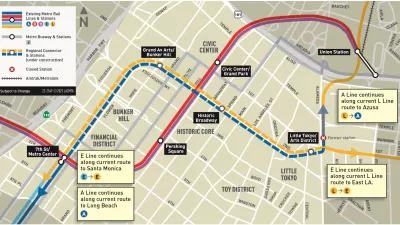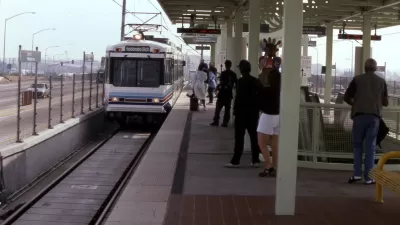New leadership at Los Angeles County's Metro says its planning efforts should consider much more than transit routes and service—including the potential for gentrification in the neighborhoods where it's investing.
"Los Angeles County Metropolitan Transportation Authority CEO Phil Washington wants his agency to do more to prepare for gentrification around new transit lines and help prevent the displacement of longtime residents," according to a column by Kerry Cavanaugh.
"Washington, who has been on the job for seven months, said too many transportation officials believe their sole responsibility is the transit line and that they have no interest in the development that occurs around the stations. The result is that low-income residents and businesses are often displaced shortly after new transit lines open."
Washington's opinion comes out clearly on one side of a debate that has occurred around Metro for years—but especially as the system builds out new rail infrastructure all over the region, including into neighborhoods with large populations of low-income and minority residents. A sign of Metro leadership's agreement with Washington on the issue came in March 2015, when the Metro board of directors "[voted] to set a goal that 35% of all apartments and condos built on land no longer needed by Metro be set aside for low-income residents," according top Cavanaugh.
Putting its money where Washington's mouth is, later this month Metro will consider ten sites as pilot projects in its Transit-Oriented Community Demonstration Program.
FULL STORY: Metro CEO says transit agencies need to care about gentrification

Planetizen Federal Action Tracker
A weekly monitor of how Trump’s orders and actions are impacting planners and planning in America.

Congressman Proposes Bill to Rename DC Metro “Trump Train”
The Make Autorail Great Again Act would withhold federal funding to the system until the Washington Metropolitan Area Transit Authority (WMATA), rebrands as the Washington Metropolitan Authority for Greater Access (WMAGA).

The Simple Legislative Tool Transforming Vacant Downtowns
In California, Michigan and Georgia, an easy win is bringing dollars — and delight — back to city centers.

The States Losing Rural Delivery Rooms at an Alarming Pace
In some states, as few as 9% of rural hospitals still deliver babies. As a result, rising pre-term births, no adequate pre-term care and "harrowing" close calls are a growing reality.

The Small South Asian Republic Going all in on EVs
Thanks to one simple policy change less than five years ago, 65% of new cars in this Himalayan country are now electric.

DC Backpedals on Bike Lane Protection, Swaps Barriers for Paint
Citing aesthetic concerns, the city is removing the concrete barriers and flexposts that once separated Arizona Avenue cyclists from motor vehicles.
Urban Design for Planners 1: Software Tools
This six-course series explores essential urban design concepts using open source software and equips planners with the tools they need to participate fully in the urban design process.
Planning for Universal Design
Learn the tools for implementing Universal Design in planning regulations.
Smith Gee Studio
City of Charlotte
City of Camden Redevelopment Agency
City of Astoria
Transportation Research & Education Center (TREC) at Portland State University
US High Speed Rail Association
City of Camden Redevelopment Agency
Municipality of Princeton (NJ)





























